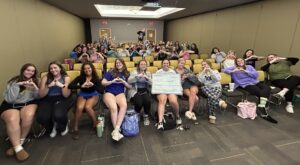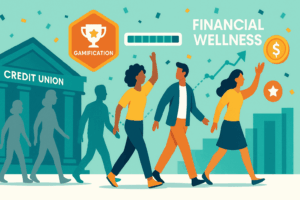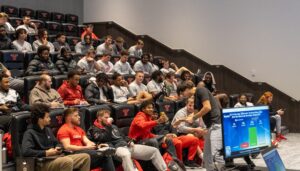College students and their parents are calling for universities to provide personal finance programs that teach financial literacy. At Ostrich, we specialize in financial literacy paired with actions, that leads to tangible outcomes. Below, you’ll find our playbook for implementation of a successful financial literacy program at the university level.
While financial literacy as a concept is extremely important, multiple studies examining the efficacy of financial literacy programs found that they only change behavior .1%. This means that even if a university provides financial literacy programming it likely won’t make a real difference to the lives of students.
Does that mean financial literacy programs should be abandoned? No, but it does mean that adding a course or program will likely fall short of driving real change.
Ostrich provides a financial health app and financial literacy programming for college students that focuses on driving outcomes. We’ve learned how to ensure financial literacy programming leads to the improved outcomes that students, parents, and universities desire.
The college population Ostrich works with sees a 50% reduction in students not building credit and who don’t know their credit score, a 30% increase in students investing, and 34% increase in emergency fund savings.
Ostrich will guide you through how to create a comprehensive personal finance program for your university that leads to outcomes that students and parents care about. Lastly, Ostrich will show you how to make it FUN!
We’ll cover:
-
- How to implement a new program;
-
- What personal finance content to cover;
-
- How to maximize engagement;
-
- How to use incentives effectively;
-
- The metrics to measure success; and
-
- How to incorporate FUN into your program!
Define Your Success Metrics
Financial literacy programming explains just 0.1% of financial behavioral change. In other words, it has no effect on the actions people take. As such, defining success for your program is incredibly important.
Do you want your program to merely tick a box or do you want to see impact on students lives?
If your aim is simply that your students understand what a stock is or how a mortgage works then there are plenty of programs out there.
However, we like to think that you’d want to see your students spend within their means, stay out of debt, build credit, save and invest! If so, your approach to personal finance programming must be with metrics that measure those behaviors.
Enabling students to regurgitate information on a test or in an essay is not enough. To measure success, you need to understand where your students’ finances are at the start of the program, and how they’ve evolved by the end.
You should understand:
-
- Whether students spend within their means;
-
- Whether they carry debt;
-
- What accounts they have, for example:
-
- Savings;
-
- Emergency fund;
-
- Credit card;
-
- Brokerage;
-
- IRA;
-
- Roth IRA; and
-
- What accounts they have, for example:
-
- Whether they know their credit score.
These metrics will give you a baseline on where your students are at the beginning of programming and the impact you’ve had on those metrics at the end.
To help with measurement, Ostrich provides a free financial health score for college students that gives a baseline of where students stand at a given point in time.
The Ostrich financial health score is used to show progression by tracking the financial health of students over time, allowing a university to measure real impact. The score also recognizes that every student starts in a different financial position with varying degrees of knowledge.
What Content Should you Cover?
There is a plethora of personal finance topics you could cover in a program. The decision on what all to cover will depend on the amount of time you have with students, their level of personal finance knowledge, and what metrics you use to measure success.
For example a one off 60-minute workshop will have a different set of content and goals than a semester long course.
Regardless of your program’s length, avoid the common pitfall of overstuffing personal finance programs with too much content.
Lastly, the topics you cover should be foundational and actionable. The aim is to change behavior and lead college students to better financial outcomes.
Topics that Ostrich recommends include:
-
- Building credit safely;
-
- Saving;
-
- Investing;
-
- Student loans and debt; and
-
- Spending
Let’s take a deeper look at each area!
Building Credit Safely
Credit building is an essential plank of any college personal finance program. Credit ties in to many other key areas of personal finance, and is often hardest to navigate immediately after graduation.
Did you know that a credit score of below 620 costs the average American $400,000 in interest payments across their lifetime? Helping your students start building credit early can have a huge impact on their financial lives, and it’s so easy!
The key aim is to establish what credit is, why it is important, and how to build it safely. Using examples of other college students or from your own life is an effective way to demonstrate the importance.
The recommended calls to action are:
-
- Have students check their credit score; and
-
- Build credit through a safe product like a secured loan or a credit building debit card.
For example, Chime offers a free checking account with a debit card that builds credit. Employed students can take advantage of this without needing to apply and qualify for a traditional credit card.
Here are some questions about building credit to answer in your personal finance program:
-
- What is credit?
-
- Why is credit important?
-
- How do you build credit safely?
-
- What does success look like?
-
- What step can you take today to build credit?
Saving
Saving is a concept that almost all college students understand. This enables us to dig a little deeper than just the concept that it’s good to avoid spending all of your money at once! Focusing on small changes, like maximizing savings through high-yield savings accounts and avoiding banks that charge fees, can make a big difference in the long run.
You can also get examples of how students are able to set and achieve savings goals while in school.
Our recommended call to action is to run a savings challenge to encourage student to save. This will be more valuable to some than others, but for everyone savings is an important topic to cover in personal finance programming.
Here are some questions about saving to answer in your personal finance program:
-
- What is saving?
-
- Why is saving important?
-
- How can you save?
-
- What does success look like?
-
- What steps can you take to today to save more?
Investing
The topic of investing is exciting to some and a big scary thing to others. You’ll need to be able to speak to both mentalities.
Our recommendation is to use simple examples to explain compound interest, the rule of 72, why time is the biggest asset when it comes to long-term investing, dollar cost averaging and index funds.
Additionally, you can cover the Traditional and Roth IRA options for investing in this section. Explaining the nuances of Traditional vs. Roth can be overkill depending on the crowd and amount of time you have to cover the topic of investing.
Our action recommendation for students is to setup a Roth IRA for those who have income. There are a lot of great providers but our favorite for Roth IRAs currently is Fidelity because it’s a free account and they allow for fractional share purchases. This allows students to dollar cost average properly.
Another great passive recommendation for students is Acorns for their roundup and dollar cost averaging feature, but they do have a monthly subscription fee that users have to pay.
Once the money has been contributed to a Roth IRA we suggest low cost index funds – one that our founders personally hold significant amounts of is Vanguard’s S&P 500 index fund VOO.
Here are some questions about investing to answer in your personal finance program:
-
- What is investing?
-
- Why is investing important?
-
- How can you invest?
-
- What does success look like?
-
- What steps can you take to start investing safely today?
Student-loans & debt
When it comes to student loans, most students who have them better understand them in comparison to other financial topics. This is because the school Financial Aid Office often helps them through this process. Still, we’ve run into instances where students didn’t know they had unsubsidized loans or that private loans have different payback terms.
Student-loans tend to be more individualized. We recommend focusing on how they impact credit score, when students have to start repaying, and that they must apply for deferment if going to graduate school.
The recommended actions for student loans are to review outstanding loans, and talk to parents and the Financial Aid Office to fully understand what each student has in their name.
When it comes to debt, most students understand what debt is. However, explaining how credit cards work and the difference between high interest rate debt and low-interest rate debt is extremely helpful. It can be useful here to use student loans as an example of relatively cheap debt, that can be ok to hold for a long period.
Our recommended actions for debt is for students to understand how much they have and to avoid credit card debt as much as possible if they have a credit card.
Here are some questions about student loans and debt to answer in your personal finance program:
-
- What is debt?
-
- Why is debt important?
-
- How can you manage debt?
-
- What does success look like?
-
- What steps can you take to today to minimize bad debt?
Spending (A Better Way to Introduce Budgeting)
Rather than talking about budgeting as it’s own topic, Ostrich has found that spending is something that students understand and engage with more easily. Focusing on spending habits and placing budgeting in the context of spending makes it more palatable to the majority of students, who (like most of the population) often cringe at the first mention of a budget.
Our recommended action step is to run a short spending challenge where students track their spending in one category they’d like to cut down. This is almost always eating out or online shopping, surprise surprise! After tracking it for a week, they then set themselves a goal for the next week, and see if they can cut back.
Ostrich’s free app features the Category Blackout challenge that students can join to track their progress.
Here are some questions about spending to answer in your personal finance program:
-
- What is spending?
-
- Why is spending important?
-
- How can you manage your spending?
-
- What does success look like?
-
- What steps can you take to today to build better spending habits?
There are other topics we may touch on like taxes, auto loans, mortgages, 401(k)s, and so on. Though we tend to spend less time on them because they are not immediately actionable for most students. Our aim is to create relevant financial literacy programming that leads to real outcomes.
As students build confidence and see success in the basics, they’ll be more engaged in these more advanced topics naturally as they become relevant.
How to Successfully Rollout Your Personal Finance Program
One of the most important determinants of the success of a financial literacy program for college students is how it is rolled out.
The aim is to maximize participation, engagement, and outcomes.
The key is nailing those 3 areas in that order.
Reaching as many students as possible and maximizing the reach of your program will help ensure the largest impact.
Required vs. Optional
If the program is required of students, then you’re going to get a large number of participants. However, this means engagement during the program should be a key focus. Creating a fun and engaging program that turns the just “I’m just here so I don’t get fined” folks into highly engaged “I want to be here” folks is the aim.
If the program is not required than marketing and roll out becomes extra crucial. Unfortunately Ostrich has seen really amazing personal finance programs fail, not because they weren’t well thought out and resources weren’t invested, but because not enough time was spent publicizing the program to ensure participation.
Ostrich has found success piggybacking on existing student meetings, groups, organizations or infrastructure. Creating a brand new event is hard. Becoming a part of existing meetings, programming, or regular events makes life a lot easier as students are already familiar with that schedule and the people in the group. Additionally, you reduce the workload for the organizers and admin. Adding as little extra work to admin and students’ plates as possible is another key determinant of success.
Incentives and marketing are key for engagement during but also for driving attendance. Free food, t-shirts, and other rewards boost attendance and engagement.
Outcomes tie to our key metrics that we outlined at the top. The only way to achieve outcomes is to ensure enough people show up and that they are engaged. Again, rewards can and should be used to incentivize positive actions.
Ensuring Strong Engagement Throughout Your Personal Finance Program
Engagement is predicated on creating a fun and relevant event. The more fun you can make your personal finance program the more effective it will be. Ostrich has seen this first hand that adding gamification elements, prizes, surprises, and pop culture lead to more fun and higher engagement.
You’ve done all the hard work of creating this personal finance program for you college students, developing the topics, and getting students to show up. Now it’s about keeping them engaged and leave them wanting more.
Ostrich has found that games like trivia, spin the wheel, challenges, lotteries, raffles, and simulations present a fun and effective way to disseminate information.
Using Incentives To Drive Outcomes
Simple incentives like free food, products, gift cards, and experiences are all effective.
Equally important, incentives should be used to reinforce the right behavior in conjunction with engagement. A student answering a question, offering an opinion or personal experience to the rest of the group is incentive worthy behavior. The answer isn’t what’s important. A student could be totally wrong. But the engagement is key so it’s up to you as the facilitator to make that clear.
Everyone loves a well placed pop culture reference that lightens the mood and allows you to connect with the audience in a different way. These also help break up the potential monotony of a barrage of financial information being thrown at you as a student.
Additionally, incentivizing the right actions is key. When Ostrich crafts challenges we place incentives to align with positive actions, like checking your credit score or setting up an emergency fund.
At the end of the day, the metrics that matter are related to behavior change which only comes from taking actions. An effective financial literacy program leads to positive actions that, over time, lead to real outcomes for students.
Conclusion
Unfortunately almost all financial literacy programs and personal finance initiatives fail to drive real outcomes for college students. Ostrich’s comprehensive personal finance program for colleges and universities highlights the keys to ensuring that your program is one of the few that delivers better financial outcomes for students. Ensuring your program uses the right metrics for success, covers the correct topics, and optimizes for engagement will all increase your chances of delivering a killer personal finance program.
Ostrich has free tools that you and your students can use to help deliver those outcomes. Additionally, Ostrich offers paid programs and analytic tools for universities that want a turnkey experience.














